文章信息
- 陆龙, 曹毅敏, 杨琼英, 贺晴, 董智强, 狄飚, 傅传喜, 王鸣.
- Lu Long, Cao Yimin, Yang Qiongying, He Qing, Dong Zhiqiang, Di Biao, Fu Chuanxi, Wang Ming.
- 小月龄婴儿母传麻疹抗体水平动态变化的纵向研究
- Dynamic maternal measles antibody level in infants:a longitudinal study
- 中华流行病学杂志, 2016, 37(5): 663-667
- Chinese Journal of Epidemiology, 2016, 37(5): 663-667
- http://dx.doi.org/10.3760/cma.j.issn.0254-6450.2016.05.015
-
文章历史
- 收稿日期: 2015-10-12
2. 510440 广州市疾病预防控制中心病毒免疫部;
3. 510440 广州市疾病预防控制中心艾滋病预防控制部;
4. 510440 广州市疾病预防控制中心免疫规划部;
5. 510440 广州市疾病预防控制中心业务管理部;
6. 510440 广州市疾病预防控制中心基层公共卫生部;
7. 510440 广州市疾病预防控制中心主任室
2. Virology and Immunology Laboratory, Guangzhou Municipal Center for Disease Control and Prevention, Guangzhou 510440, China;
3. Department of AIDS/STD Control and Prevention, Guangzhou Municipal Center for Disease Control and Prevention, Guangzhou 510440, China;
4. Department of Immunization Program, Guangzhou Municipal Center for Disease Control and Prevention, Guangzhou 510440, China;
5. Executive Office for Managing Action in Disease Control and Prevention, Guangzhou Municipal Center for Disease Control and Prevention, Guangzhou 510440, China;
6. Department of Primary Public Health, Guangzhou Municipal Center for Disease Control and Prevention, Guangzhou 510440, China;Guangzhou Municipal Center for Disease Control and Prevention, Guangzhou 510440, China;
7. Director Office, Guangzhou Municipal Center for Disease Control and Prevention, Guangzhou 510440, China
麻疹疫情近年来呈上升趋势,2012年全球报告122 000例死亡病例[1]。在北美洲宣布已成功阻断麻疹病毒本地传播的几年后,加拿大、美国等再次出现麻疹疫情暴发[2, 3]。近年我国麻疹发病也大幅升高[4, 5, 6],2013年全国麻疹发病率由历史最低点0.46/10万,回升至2.84/10万。接种麻疹疫苗是预防麻疹最为经济有效的手段[7, 8],也是降低麻疹发病率和死亡率的主要公共卫生策略。分析近年来广州市麻疹疫情,发现8月龄以下婴儿病例不断增加,与国内多地报告一致[9, 10],一些横断面调查显示,可能与新生儿出生后体内母传麻疹抗体不断衰减而又未能及时接种疫苗获得免疫力有关。为此本研究通过在广州市某妇幼保健院开展小月龄婴儿母传麻疹抗体水平消长分析,探讨减少婴儿感染麻疹病毒的免疫策略。
对象与方法1. 研究对象:随机选取2013年7月至2014年4月在广州市某妇幼保健院进行分娩的母亲及其小月龄婴儿作为研究对象,研究期间母亲和婴儿均未患过麻疹或未接种过麻疹疫苗。采用血清流行病学方法对母亲及其小月龄婴儿0、3、5和7月龄的母传麻疹抗体消长情况进行纵向研究;分析不同出生年份(根据广州市于1987年实施扩大免疫规划,分为1987年前出生和1987年及以后出生)母亲的麻疹抗体水平与小月龄婴儿麻疹抗体水平的关系,了解出生后、3、5和7月龄麻疹抗体的消长规律。本研究经广州市CDC伦理委员会的审查。
2. 问卷调查:采用自行设计问卷调查母亲基本情况和婴儿出生信息,其中第一部分由母亲自行填写,第二部分由医务人员协助填写,回收问卷时调查员需及时核对并补充可能漏填的项目。为提高研究对象的依从性,采取宣传本研究的目的、主动联系受访者、及时反馈检测结果、提供免费项目(如婴儿游泳)、提供母婴保健与免疫相关问题的免费咨询、对3~7月龄婴幼儿的生长状况提供健康评估服务等方法,以避免失访偏倚的影响。
3. 样本采集及检测:于孕妇分娩前使用5 ml一次性无菌注射器抽取上肢静脉血2 ml。新生儿脐静脉血以分娩时脐带血替代,断脐前使用5 ml一次性无菌注射器抽取2 ml静脉血;另外分别在婴儿3、5和7月龄期间各采集静脉血1 ml。所有血液样本采集后室温下静置30~60 min,3 000 r/min离心10 min,将分离出的血清转移至血清冻存管,置-20 ℃冰箱内保存,统一送广州市CDC检测。采用ELISA定量检测麻疹IgG抗体,检测试剂购自德国维润赛润公司。10 μl待测血清置1 000 μl稀释缓冲液,取100 μl样本稀释液加入微孔板内,加入2孔阳性对照血清各100 μl,1孔阴性对照血清100 μl;空白对照1孔,不加任何液体;将反应板振荡,样品混匀后置37 ℃温箱或水浴孵育60 min;浓缩洗液加蒸馏水至1 000 ml,机洗5次,每次30 s,每孔注入洗液300 μl(含空白孔),37 ℃温箱或水浴孵育30 min;每孔加入100 μl终止液(含空白孔)终止反应。使用波长405 nm进行检测,读取消光系数。
4. 判断标准:麻疹IgG抗体浓度≥200 mIU/ml为阳性,≥800 mIU/ml为保护性抗体水平。并依据抗体水平分为易感水平(<200 mIU/ml)、低抗体水平(≥200且<800 mIU/ml)、中抗体水平(≥800且<3 200 mIU/ml)、高抗体水平(≥3 200 mIU/ml)4组。
5. 统计学分析:采用EpiData 3.0 软件建立数据库,资料整理和数据分析采用SPSS 19.0软件。方法包括描述性统计分析、t检验、χ2检验、Wilcoxon 双侧检验等。检验水准α=0.05。
结 果1. 基本情况:共纳入母亲及其婴儿691对(689名母亲,691名婴儿,其中有2对双胞胎)。分娩时采集母亲外周静脉血和新生儿脐静脉血;另外在婴儿3、5及7月龄时各采集一次静脉血1 ml,分别为170、53及44份。纳入研究的母亲年龄为16~45岁,平均年龄(27.7±5.0)岁;婴儿出生体重为1.62~4.82 kg,平均(3.22±0.38)kg;男女性别比为1.1∶1;孕期为(39.3±1.2)周。
2. 麻疹抗体水平及阳性率:母亲分娩前血清麻疹抗体浓度为513.8(95%CI:450.5~585.8) mIU/ml,抗体阳性率为81.6%(562/689),其中45.1%(311/689)的母亲抗体浓度达到保护性抗体水平。按出生年份分组,1987年以前出生组母亲体内麻疹抗体浓度及抗体阳性率均高于相应1987年及以后出生组,差异均有统计学意义(P=0.013和P=0.010);但两组母亲的分娩方式、孕期、婴儿的性别和出生体重的差异均无统计学意义(P>0.05)。新生儿血清麻疹抗体浓度为732.8(95%CI:653.3~822.0)mIU/ml,抗体阳性率为87.3%(603/691),其中有54.7%(378/691)的新生儿体内抗体浓度达到保护性抗体水平(表 1、2)。
3. 母婴麻疹抗体水平的关系:将691对母婴的血清麻疹抗体浓度值进行对数转换,绘制散点图进行相关性分析(图 1)。结果显示,两者血清麻疹抗体水平呈正相关(r=0.917 5,P<0.001)。新生儿的整体麻疹抗体浓度及易感水平组、低抗体水平组、中抗体水平组的婴儿麻疹抗体浓度均高于相应母亲组,差异均有统计学意义(P值均<0.001)。见表 3。
 |
| 图 1 母婴血清麻疹抗体浓度相关性分析 |
4. 婴儿血清麻疹抗体水平变化趋势:691名婴儿出生时血清麻疹抗体浓度为732.8(95%CI:653.3~822.0) mIU/ml,出生后到3月龄时体内麻疹抗体浓度下降为72.1(95%CI:53.4~97.2) mIU/ml,为出生时的9.8%;5月龄以后抗体浓度降至40 mIU/ml以下。新生儿血清麻疹抗体阳性率为87.3%,3月龄时为26.5%,5、7月龄时阳性率分别为20.8%和2.3%,阳性率随月龄增加而迅速降低(表 2和图 2)。
 |
| 图 2 不同月龄婴儿血清麻疹抗体水平变化趋势 |
按母亲出生年份将婴儿分为两组,即母亲1987年以前出生组和母亲1987年及以后出生组。两组新生儿的麻疹抗体浓度分别为850.9(95%CI:742.4~968.4)mIU/ml和608.5(95%CI:503.4~734.4)mIU/ml,两组婴儿自出生后体内的麻疹抗体迅速下降,3月龄时分别降至出生时的7.8%和4.2%(表 2和图 3)。
 |
| 图 3 不同年份出生母亲所生婴儿组和婴儿不同麻疹抗体水平组抗体变化趋势 |
5. 婴儿不同麻疹抗体水平组抗体变化趋势:婴儿自出生至3月龄时体内的麻疹抗体水平迅速下降。其中低抗体水平组、中抗体水平组婴儿麻疹抗体水平均在3月龄时转为阴性,而高抗体水平组在5月龄时的抗体水平仍为阳性[474.6(95%CI:274.2~821.3)mIU/ml],到7月龄时转为阴性(图 3)。
讨 论本研究显示,母亲血清麻疹抗体浓度为513.8(95%CI:450.5~585.8) mIU/ml,抗体阳性率为81.6%,与马瑞等[11]研究结果相似,但高于还锡萍等[12]研究结果,低于张玮等[13]、Leuridan等[14]研究结果,表明母亲感染麻疹病毒和疫苗接种水平具有一定的地区差异。同时还观察到,婴儿出生时血清麻疹抗体浓度是其母亲的1.43倍,提示胎盘对母传麻疹抗体具有浓缩作用。在一些国家和地区的婴儿中亦观察到母传麻疹抗体的胎盘浓缩作用[11, 15, 16, 17],但也有研究未观察到类似现象[15, 18, 19, 20, 21],可能与当地育龄期妇女麻疹抗体平均水平及人群、地域特点有关。
广州市自1987年开始将麻疹疫苗纳入免疫规划。1987年以前出生母亲的麻疹抗体水平显著高于1987年及以后出生的母亲,提示计划免疫时代母亲体内麻疹抗体水平偏低。与此相应,前者所生婴儿的血清麻疹抗体水平也显著高于后者的婴儿。比利时、英国、波兰等研究均显示自然感染免疫的母亲及其婴儿的血清麻疹抗体水平高于接种疫苗的母亲及其婴儿[14, 22, 23]。推测其原因可能是,接种麻疹疫苗的母亲对麻疹病毒的免疫主要来自疫苗诱导,所激发的免疫持久性低于自然感染者[24]。
本次观察到婴儿3月龄时母传麻疹抗体平均水平迅速下降,与国内外学者报告的结果类似[11, 14, 18]。进一步分析发现,高抗体水平组婴儿(≥3 200 mIU/ml)在5月龄时麻疹抗体水平仍为阳性,提示其抗体可维持较长时间。鉴于母婴麻疹抗体水平呈正相关,提示通过检测母亲麻疹抗体水平可外推新生儿的母传麻疹抗体水平,从而适当调整麻疹疫苗首剂接种年龄。对于高麻疹抗体水平的母亲,其婴儿不需提前麻疹疫苗首剂接种年龄。国内研究显示[25],各年龄段育龄期妇女接种疫苗后麻疹抗体阳性率均显著高于接种前;因此建议育龄期妇女孕前接种麻疹疫苗以提高自身麻疹抗体水平,从而提高婴儿在接种首剂麻疹疫苗前的免疫力,减少小月龄婴儿的麻疹病例。
本研究存在不足。由于婴儿采血困难,后期样本失访较严重,可能存在一定的失访偏倚;其次样本仅来自一所医院,代表性差,其外推有限。
志谢 调查中得到广州市CDC、广州市荔湾区妇幼保健院相关人员的大力协助 利益冲突 无| [1] World Health Organization. Measles[EB/OL]. (2014-02-21)[2014-08-10]. http://www.who.int/immunization/monitoring_surveillance/burden/vpd/surveillance_type/active/measles/en/. |
| [2] Dallaire F,de Serres G,Tremblay FW,et al. Long-lasting measles outbreak affecting several unrelated networks of unvaccinated persons[J]. J Infect Dis,2009,200(10):1602-1605. DOI:10.1086/644783. |
| [3] Dayan GH,Quinlisk MP,Parker AA,et al. Recent resurgence of mumps in the United States[J]. N Engl J Med,2008,358(15):1580-1589. DOI:10.1056/NEJMoa0706589. |
| [4] 马超,郝利新,苏琪茹,等. 中国2011年麻疹流行病学特征与消除麻疹进展[J]. 中国疫苗和免疫,2012,18(3):193-199. DOI:10.3969/j.issn.1006-916X.2012.03.001. Ma C,Hao LX,Su QR,et al. Measles epidemiology and progress towards measles elimination in China,2011[J]. Chin J Vaccin Immuniz,2012,18(3):193-199. DOI:10.3969/j.issn.1006-916X. 2012.03.001. |
| [5] 马超,罗会明,安志杰,等. 中国2006-2007年麻疹流行病学特征及消除麻疹措施分析[J]. 中国疫苗和免疫,2008,14(3):208-213. DOI:10.3969/j.issn.1006-916X.2008.03.004. Ma C,Luo HM,An ZJ,et al. Analysis on epidemiological characteristics and measures of measles control in China during 2006-2007[J]. Chin J Vaccin Immuniz,2008,14(3):208-213.DOI:10.3969/j.issn.1006-916X.2008.03.004. |
| [6] 马超,郝利新,马静,等. 中国2010年麻疹流行病学特征与消除麻疹进展[J]. 中国疫苗和免疫,2011,17(3):242-248. DOI:10.3969/j.issn.1006-916X.2011.03.012. Ma C,Hao LX,Ma J,et al. Measles epidemiological characteristics and progress of measles elimination in China,2010[J]. Chin J Vaccin Immuniz,2011,17(3):242-248. DOI:10.3969/j.issn. 1006-916X.2011.03.012. |
| [7] Yang ZC,Xu JX,Wang M,et al. Measles epidemic from 1951 to 2012 and vaccine effectiveness in Guangzhou,southern China[J]. Hum Vaccin Immunother,2014,10(4):1091-1096. DOI:10.4161/hv.27895. |
| [8] Tubeuf S,Edlin R,Shourie S,et al. Cost effectiveness of a web-based decision aid for parents deciding about MMR vaccination:a three-arm cluster randomised controlled trial in primary care[J]. Br J Gen Pract,2014,64(625):e493-499. DOI:10.3399/bjgp14X680977. |
| [9] 赵春艳,王宝兰,宁召起. 2005-2010年北京市通州区麻疹暴发疫情流行病学特征[J]. 首都公共卫生,2011,5(5):210-212. DOI:10.3969/j.issn.1673-7830.2011.05.005. Zhao CY,Wang BL,Ning ZQ. Epidemiological characteristics of measles outbreaks in Tongzhou district,Beijing during 2005-2010[J]. Cap J Public Health,2011,5(5):210-212. DOI:10.3969/j.issn.1673-7830.2011.05.005. |
| [10] 宫秀文,苏金梅,宋桃仁. 阿拉善盟2008年两起学校麻疹暴发流行疫情分析[J]. 疾病监测与控制杂志,2011,5(9):548-549. Gong XW,Su JM,Song TR. Analysis on measles outbreaks epidemics in two schools in Alashan,2008[J]. Dis Monit Control,2011,5(9):548-549. |
| [11] 马瑞,许国章,徐宏杰,等. 小月龄婴儿麻疹母传抗体消长研究[J]. 中国疫苗和免疫,2008,14(3):226-228. DOI:10.3969/j.issn.1006-916X.2008.03.007. Ma R,Xu GZ,Xu HJ,et al. Study on changing of maternal transferred measles antibody level in infants[J]. Chin J Vaccin Immuniz,2008,14(3):226-228. DOI:10.3969/j.issn.1006-916X.2008.03.007. |
| [12] 还锡萍,陶红,陆培善,等. 母婴配对及不同月龄婴儿麻疹减毒活疫苗免疫后抗体水平分析[J]. 中国计划免疫,2007,13(2):126-129. DOI:10.3969/j.issn.1006-916X.2007.02.007. Huan XP,Tao H,Lu PS,et al. Antibody level analysis and comparison in maternal-infant pairs and vaccinated infants of 6 and 8 months[J]. Chin J Vaccin Immuniz,2007,13(2):126-129. DOI:10.3969/j.issn.1006-916X.2007.02.007. |
| [13] 张玮,杨卫路,狄飚,等. 婴儿麻疹胎传抗体及初次接种麻疹疫苗免疫效果观察[J]. 中国初级卫生保健,2000,14(12):44-45. DOI:10.3969/j.issn.1001-568X.2000.12.023. Zhang W,Yang WL,Di B,et al. A study on level of antibody against measles through maternal fetal transfer and immune response to measles vaccine[J]. Chin Prim Health Care,2000,14(12):44-45. DOI:10.3969/j.issn.1001-568X.2000.12.023. |
| [14] Leuridan E,Hens N,Hutse V,et al. Early waning of maternal measles antibodies in era of measles elimination:longitudinal study[J]. BMJ,2010,340:c1626. DOI:10.1136/bmj.c1626. |
| [15] Hartter HK,Oyedele OI,Dietz K,et al. Placental transfer and decay of maternally acquired antimeasles antibodies in Nigerian children[J]. Pediatr Infect Dis J,2000,19(7):635-641. DOI:10.1097/00006454-200007000-00010. |
| [16] 凌立省,周晓芹,刘金宝,等. 母婴麻疹抗体水平及相互关系的初步研究[J]. 检验医学与临床,2010,7(4):321-322. DOI:10.3969/j.issn.1672-9455.2010.04.018. Ling LS,Zhou XQ,Liu JB,et al. The study of maternal infant measles immune body level and reciprocity[J]. Lab Med Clin,2010,7(4):321-322. DOI:10.3969/j.issn.1672-9455.2010.04. 018. |
| [17] 刘方,王珊,王晨,等. 新生儿母传麻疹抗体水平与相关因素调查[J]. 中国妇幼保健,2012,27(30):4751-4754. Liu F,Wang S,Wang C,et al. Investigation on the level of maternal transferred measles antibody in neonates and relative factors[J]. Matern Child Health Care China,2012,27(30):4751-4754. |
| [18] Zhang XW,Shirayama Y,Zhang YJ,et al. Duration of maternally derived antibody against measles:a seroepidemiological study of infants aged under 8 months in Qinghai,China[J]. Vaccine,2012,30(4):752-757. DOI:10.1016/j.vaccine.2011.11.078. |
| [19] 邓慧玲,常荣芬,张素梅,等. 西安地区8月龄内母婴配对174例麻疹抗体测定结果分析[J]. 陕西医学杂志,2005,34(1):123-125. DOI:10.3969/j.issn.1000-7377.2005.01.049. Deng HL,Chang RF,Zhang SM,et al. Measles antibody level analysis in 174 maternal-newborns within 8 months,Xi'an[J]. Shaanxi Med J,2005,34(1):123-125. DOI:10.3969/j.issn. 1000-7377.2005.01.049. |
| [20] 王联君,孙丽英,姜忠林,等. 小月龄婴儿麻疹发病控制对策探讨[J]. 中华流行病学杂志,2001,22(1):49-50. DOI:10.3760/j.issn. 0254-6450.2001.01.016. Wang LJ,Sun LY,Jiang ZL,et al. The study of countermeasures on measles control in infants[J]. Chin J Epidemiol,2001,22(1):49-50. DOI:10.3760/j.issn. 0254-6450.2001.01.016. |
| [21] 张晓华,张晓林,刘彬. 母婴麻疹抗体水平检测结果分析[J]. 中国卫生检验杂志,2008,18(6):1143-1144. Zhang XH,Zhang XL,Liu B. Analysis of antibody level to measles in mothers and their infants[J]. Chin J Health Lab Technol,2008,18(6):1143-1144. |
| [22] Brugha R,Ramsay M,Forsey T,et al. A study of maternally derived measles antibody in infants born to naturally infected and vaccinated women[J]. Epidemiol Infect,1996,117(3):519-524. DOI:10.1017/S0950268800059203. |
| [23] Janaszek W,Slusarczyk J. Immunity against measles in populations of women and infants in Poland[J]. Vaccine,2003,21(21/22):2948-2953. DOI:10.1016/S0264-410X(03)00113-0. |
| [24] Dai B,Chen ZH,Liu QC,et al. Duration of immunity following immunization with live measles vaccine:15 years of observation in Zhejiang province,China[J]. Bull World Health Organ,1991,69(4):415-423. |
| [25] 魏兴武,苏黎,叶永青,等. 婚前育龄妇女接种麻疹疫苗免疫效果观察[J]. 中国公共卫生,2005,21(8):924-925. Wei XW,Su L,Ye YQ,et al. Effects of measles vaccine on unmarried women of child-bearing age[J]. Chin J Public Health,2005,21(8):924-925. |
 2016, Vol. 37
2016, Vol. 37





